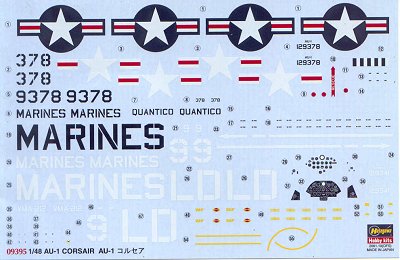
|
KIT: |
Hasegawa 1/48 AU-1 Corsair |
|
KIT # |
9395 |
|
PRICE: |
$29.95 |
|
DECALS: |
See review |
|
REVIEW & |
|
|
NOTES: |
` |

|
HISTORY |
While the Corsair originated in a requirement for a fleet defense fighter, the Marines soon discovered after they got their F4U-1As that the airplane could carry a significant amount of ordnance, and deliver it with at least as much accuracy as a Dauntless dive bomber; the F4U-1D was delivered with bomb and rocket racks as a fighter-bomber from the outset, as was the later F4U-4. From the the first ground-support sortie on Bougainville, the Corsair and the Mud Marines were inseparable for the remainder of the airplane's operational career with the U.S. In Korea, the Marine F4U-4s literally saved the First Marine Division during the retreat from the Chosin Reservoir.
The Marines finally asked for a dedicated ground-attack Corsair, optimized for maximum performance at low altitude, with the ability to carry everything including the kitchen sink if necessary. The result was the F4U-6, developed from the late series F4U-5, and distinguishable by a single-stage supercharger for low altitude operation, and quite a bit of armor plate welded on below the cockpit, under the oil coolers - which were positioned inside the fuselage rather than in the inner leading edge of the wing - and a total of ten weapons pylons underwing. With the beefed-up centerline pylons, this Corsair could carry 2 1,000 lb. bombs, and either ten 5" HVAR rockets or six 250 lb. bombs, for a total bomb load of 5,000 lbs. With this, the designation changed to AU-1, and 111 of them were built for the Marines in 1951-52, where they provided sterling service in the later stages of the Korean War.
In 1953, the United States decided to support the French in their struggle against Communist insurgents in Indochina. 30 AU-1s were taken from Japan and sent to the French Aeronavale; they served there until the French left in defeat in 1954, at which time they were returned to U.S. service. AU-1s were sent to reserve units in the U.S. after the war, and yours truly remembers climbing all over one with his best friend and fellow airplane nut the day the Blue Angels brought their F9F-5 Panthers to Buckley NAS outside Denver for Navy Day, 1955. In 1959, the surviving AU-1s were bought by France to supplement their F4U-7s for service in the Algerian War.
|
THE KIT |
Hasegawa is to be complimented for finally bringing out kits of the late model Corsairs, this AU-1 having been preceded over the past year by the F4U-5N and F4U-7. The kits are accurate and, out of the box with no additional aftermarket parts, make up into an accurate model. If you have seen the preceding kits, you know what the AU-1 box contains. The major difference from the others being the cowl.
 The kit decals provide
markings for BuNo 129341, 9-LD, a Glossy Sea Blue Korean veteran of VMA-212
"Lancers," and the well-known BuNo 129378 of Aircraft Engineering Squadron 12,
based at Quantico Virginia and flown by Col. John Bolt, USMC, in 1957; this
airplane - one of the last Corsairs still on active service with the Marine
Corps - is remarkable for being in the then-new scheme of Light Gull Grey over
Glossy White.
The kit decals provide
markings for BuNo 129341, 9-LD, a Glossy Sea Blue Korean veteran of VMA-212
"Lancers," and the well-known BuNo 129378 of Aircraft Engineering Squadron 12,
based at Quantico Virginia and flown by Col. John Bolt, USMC, in 1957; this
airplane - one of the last Corsairs still on active service with the Marine
Corps - is remarkable for being in the then-new scheme of Light Gull Grey over
Glossy White.
Unfortunately, the kit also includes the "ledge" in the forward fuseage, created by the insertion of different mold patterns at this point to cater to the detail differences of the three different airplanes. This is unfortunate, as the only way to get rid of it is with putty and sand paper, requiring substantial rescribing of the surrounding surface detail. With an overall Gloss Sea Blue airplane, this is not such a problem since the dark color makes the final result of your effort hard to see, but with the Quantico AU-1, the light grey will require you to be particularly diligent in fixing this, as it will be visible.
|
CONCLUSIONS |
Despite the "ledge" the Hasegawa Corsairs are among the best Corsair kits ever released, and this, the last of the line, is hightly recommended. I suggest you look into getting the Victory Productions decal sheet, which has better decals for the two aircraft offered here.
Thanks to Hobby Link Japan for the review kit.
If you would like your product reviewed fairly and quickly by a site that has thousands of visits a day, please contact me or see other details in the Note to Contributors.